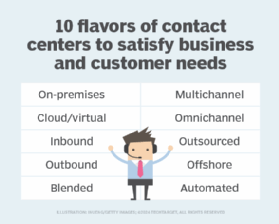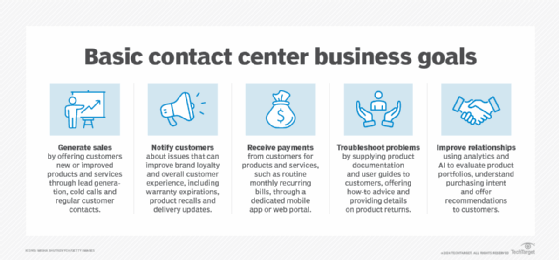10 types of contact centers explained
Contact centers are the front line of communication between the enterprise and customers. But no two facilities are alike, so it's best to know which type fits business goals.
Contact centers have fast become the primary means of communication between businesses and customers. With the support of modern technologies, contact centers can deliver documentation, manage customer accounts, generate sales and interact with agents through the phone, text messaging, email, web chat, chatbots, social media, mobile apps and video.
But no two contact centers are alike. They vary according to business goals, customer experiences and levels of expertise with underlying technologies like AI and social media integrations.
Factors that distinguish contact centers
Ultimately, every contact center aims to be the focal point of positive customer experiences and interactions, but what makes one contact center different from another? The various services and technologies embodied within a contact center are often driven by the following business landscapes.
- Contact center goals. Understand what the contact center is intended to do. Contact centers typically provide some mix of new or recurring sales, customer account management, data access and management, and product or customer support. It's generally not necessary for every contact center to do everything.
- Business focus. Contact center capabilities vary depending on the business itself. A traditional publisher, for example, might focus on selling subscriptions and access to previous content but provide little customer support beyond subscription and delivery management. By comparison, a content streaming service might emphasize subscription sales and renewals, while providing strong technical support to ensure adequate service access and performance.
- Technology platforms. Contact centers are differentiated by the underlying technologies deployed. Common technologies include traditional phone support answered by human agents but have rapidly expanded to include email, human-based chat and integrations with various social media platforms. Contact centers can also use advanced technologies like machine learning (ML) analytics and AI-based chat, which draw on expanding volumes of customer data for predictions and decision-making. Sophisticated technologies might require work from other business units such as software development.
- Service and staffing. Another distinguishing characteristic is how contact centers provide services to a business. Contact centers can be built and operated in-house or increasingly provided through a third-party service provider known as a contact center as a service (CCaaS). Similarly, the contact center could be staffed locally, remotely or at a considerable distance from the company's location to take advantage of more attractive worker skills and labor rates.

Types of contact centers
Contact centers can be classified in a variety of ways depending on factors such as the facility's purpose, relative location and underlying technologies. There are 10 broad contact center classifications, although a contact center might cover more than one of the following categories.
1. On-premises contact center
An on-premises contact center is built and operated in-house much like a local data center, with all the technology, resources and staffing typically handled by the enterprise. This type of contact center requires the greatest amount of investment, but also provides the greatest degree of brand control, customer experience and user outcomes.
2. Cloud contact center
A cloud or virtual contact center provides software-based channels, services and tools through the internet. Traditionally, they were only accessible through dedicated contact center facilities. As with other cloud offerings, businesses can engage varied services as desired, pay only for what's used and discontinue usage when needed. A cloud contact center can be used by the principal business or third-party providers regardless of physical location and anywhere cloud services can be accessed. Contact center agents who are located in different countries, operate in different time zones and speak different languages, for example, could share the same cloud-based service, such as Amazon Connect.
3. Inbound contact center
An inbound contact center typically handles incoming contacts initiated by customers. This type of contact center is often used to support customer issues and problems like a defective product, but they can also generate sales such as customer agreement renewals. The focus is on informational resources such as web portals for documentation and FAQs, which can often address many customer issues without direct human contact. Inbound contact centers also use chat and email, as well as advanced contact technologies like ML and AI for problem-solving and analytics.
4. Outbound contact center
An outbound contact center generally facilitates customer contact initiated by the company. It's most frequently used to generate sales leads by pitching product offers to new and existing customers, as well as other important communications such as product recalls or defect notifications. Immediacy is a key factor in outbound contact, so phone, text and email communication are the most relevant platforms. Sales-lead generation could also entail access to customer data, extensive data entry task, and real-time billing or payment systems.
5. Blended contact center
A blended contact center supports inbound and outbound contact through the same facility, sharing the traits of both types of contact centers. A well-planned blended contact center can provide improved customer experience, business flexibility and workflows, while offering shorter wait times and more comprehensive agent interactions because agents have access to more customer history and data. But a blended contact center can be more complex and expensive than an inbound or outbound contact center alone, requiring a clear strategy and detailed metrics for success.
6. Multichannel contact center
A multichannel contact center provides a variety of mechanisms or channels for communication. Common channels include phone, email, text, SMS, mobile apps, web apps and social media platform integrations. Although a multichannel contact center can offer various means of contact, it doesn't provide or support all types of contact, thus lowering costs for businesses that don't want or can't support every possible communication channel. But customers might be dissatisfied with a lack of channel alternatives. A younger customer familiar with social media, for example, might find a limited customer experience when contacting a business that doesn't support their preferred channel.
7. Omnichannel contact center
An omnichannel contact center provides and supports the broadest possible array of contact mechanisms. As with multichannel facilities, omnichannel contact centers can include phone, email, text, SMS, mobile apps, web apps and social media platform integrations. But omnichannel efforts go beyond just the number of channels. Agents and their AI counterparts have access to the most comprehensive scope of customer data and contact history.
8. Outsourced contact center
An outsourced contact center is fundamentally a CCaaS in which some or all the contact center's functionality is provided through a third party. Outsourcing is helpful when a business lacks the expertise or resources to own and operate its own fully featured contact center. CCaaS, for instance, might be preferable because it provides languages, technologies and contact channels the business currently can't support. CCaaS relationships also can be changed or terminated as needed, so businesses can closely manage costs and services related to contact center operations. The business, however, has no direct control over the contact center's operations or customer outcomes.
9. Offshore contact center
An offshore contact center is usually located in a country different than the principal business. In actual practice, the contact center might be owned and operated by the company's subsidiary or an outsourced third-party provider. Enterprises are then able to support other languages, lower labor costs and handle diverse time zones for strategic 24/7/365 support. But businesses must consider potential language, time, workforce, regulatory, legal and security issues before making an offshore commitment.
10. Automated contact centers
An automated contact center focuses on using ML and AI technologies to implement high levels of automation into contact center operations. This type of contact center embraces the use of chatbots, natural language processing and speech recognition to gather information, analyze customer data and histories, and perform basic customer inquiries. In many cases, this approach can generate sales leads and even resolve customer issues without the need for a human agent, who would only get involved when automated technologies have exhausted all reasonable avenues of resolution.

Choosing the right contact center for your business
Whether building a contact center in-house from scratch or engaging third-party contact center services, business and technology leaders should carefully evaluate several key issues that can drive the decision-making process, including the following:
- Contact platforms. How will customers reach the company? Types of contact can range from traditional customer calls to email, chat, video, mobile apps and social media platforms. It's the many (multichannel) versus all (omnichannel) debate. The range of communication channels will affect the complexity and cost of the contact center, but greater contact diversity can provide more immediate and positive customer experiences across a broader customer demographic.
- Integrations. Today's contact centers go far beyond connecting with social media. They must integrate seamlessly with an increasing variety of enterprise applications such as database, CRM, ERP and other vital platforms. These integrations are useful for accessing customer data, tracking customer contact history and interfacing with other aspects of the business such as inventory, shipping and sales.
- Analytics and reporting. Contact center performance is typically measured by an assortment of metrics and KPIs. A support center, for example, might use software tools to track the number or rate of tickets, the time to resolve the ticket and then attempt to gauge customer experience based on user feedback or an approval rating. Other analytics might process performance into cost metrics: Taking the average time to resolve a ticket multiplied by the total cost per hour for the contact center resources used can yield an approximate cost per incident or ticket. All these results can provide an objective view of the contact center's performance and business value.
- Data security. Contact centers access and process a significant amount of data, which can include customer personally identifiable information and sensitive business communications. All the data generated and monetized by the contact center must be properly stored, secured and retained according to prevailing regulatory obligations and business governance standards, including proper identify and access management, least privilege guidelines, data encryption, acceptable use guidelines and corresponding enforcement.
- Scalability. Contact centers typically have finite resources and can only process a limited number of contacts in a given time. As the business grows, the contact center must be able to scale to meet increasing customer contact and support demands. Upgrades can include network bandwidth, storage capacity, the number of existing software tools available (software seats), and human staffing.
- Scope. Contact centers could be limited in the number of geographic regions they support -- at least through some channels. Phone support during business hours in North America, for example, might not be well suited to customers in the EU or Asia. Different contact platforms might suit different reach. Increasing legislation in different countries and regions could also limit the reach and operations of contact centers. Contact centers operating in the EU and subject to the GDPR might need to apply different rules and workflows compared to those operating in the U.S. or individual U.S. states. The greater the business scope, the more complex the contact center's regulatory and operational landscape.
Stephen J. Bigelow, senior technology editor at TechTarget, has more than 20 years of technical writing experience in the PC and technology industry.








